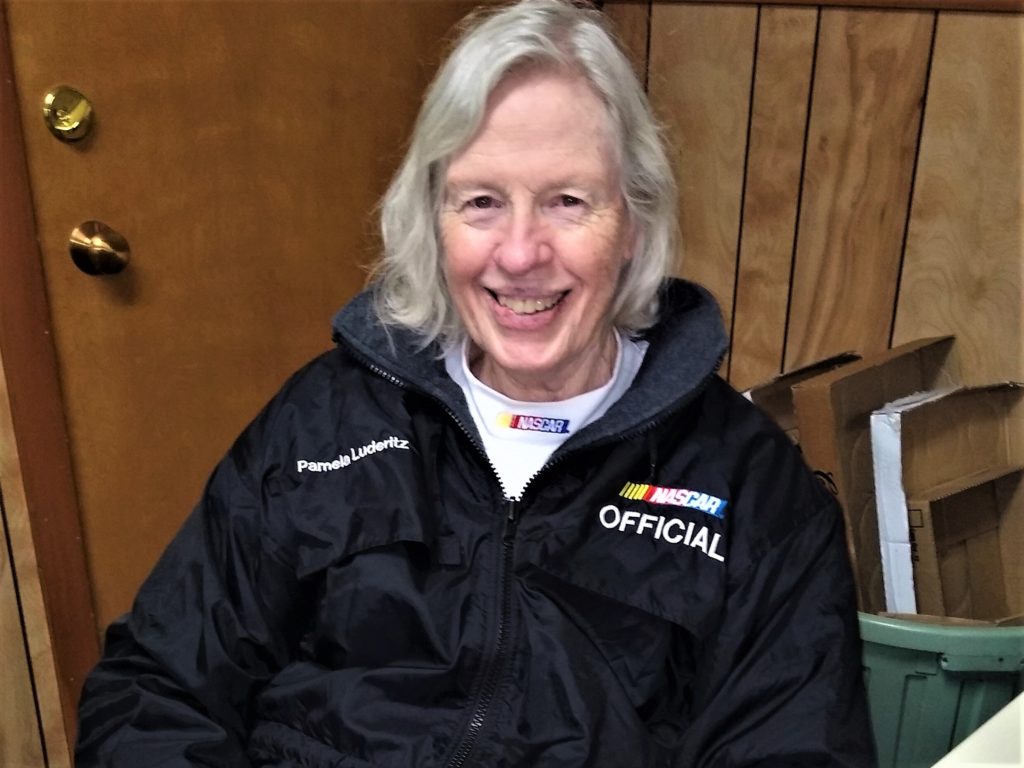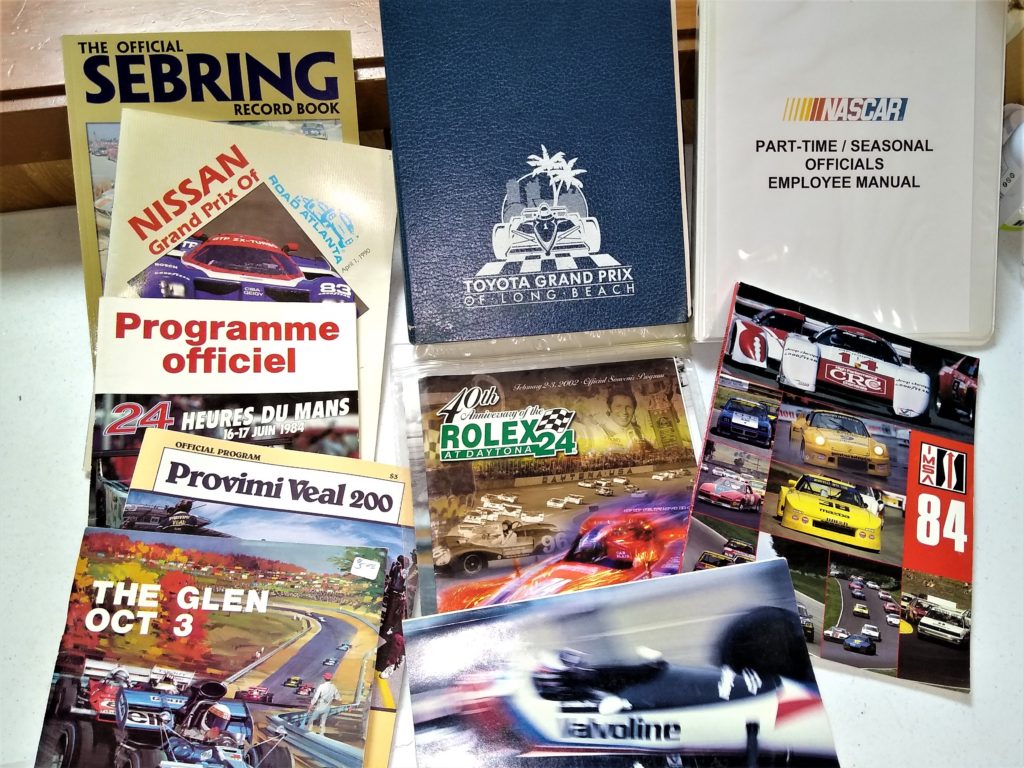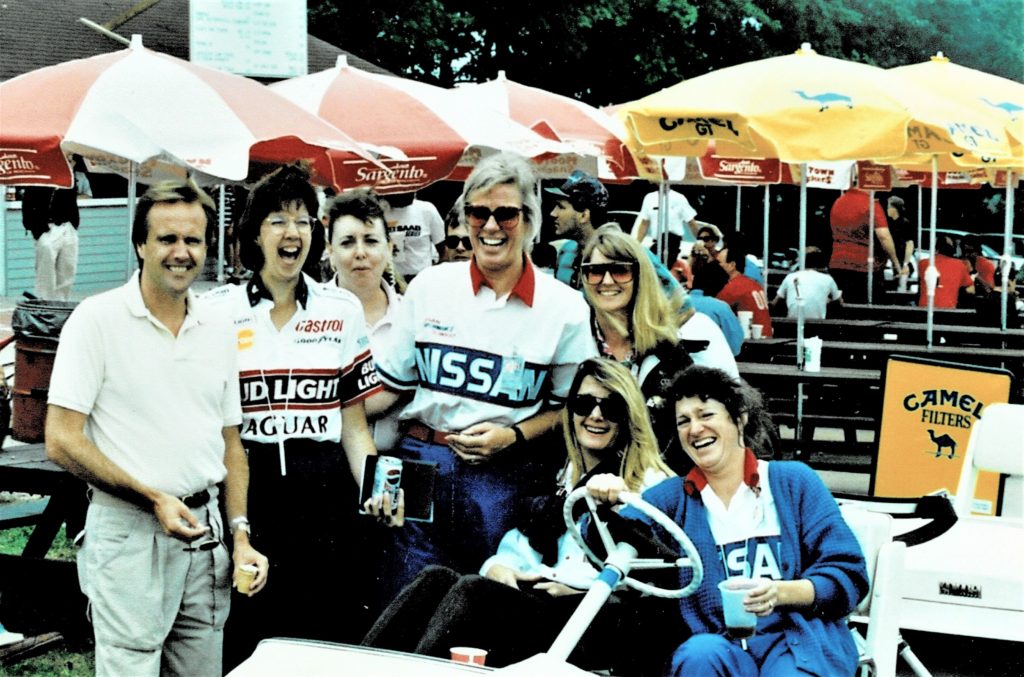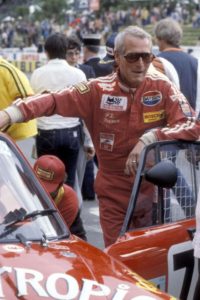
By CHERYL ROMANO/YachatsNews.com
YACHATS — She just doesn’t look the part. White hair tops a tall frame, and she walks with a cane pending surgery this winter. She’s a deacon and an elder at Yachats Community Presbyterian Church, where she coordinates the food pantry.
But for years, this Yachats resident travelled the globe in the high-speed, high-risk world of race cars. You’d probably never guess, just to look at Pam Luderitz.
She worked at Florida’s Daytona 500, Grand Touring and stock car races in Mexico City, the 24 Hours of LeMans in France. She’s rubbed elbows with famous drivers like Mario Andretti and Dan Gurney. Driver/actor Paul Newman once carried her papers. She wore the official staff jackets of Team Nissan and NASCAR (National Association for Stock Car Auto Racing).

All of this in an era when women in professional racing were rare.
“When I look back I’m surprised at what I did,” Luderitz says today. “We didn’t realize we were laying any ground. It was just something we did … something we loved.”
What she loved was being a timer and scorer in major motor sports. Working with a stopwatch, pen and paper, timers do just what the name says — record how long a car takes to go around a track. A scorer, using the same tools, keeps track of who finishes a race in what order — and that determines the size of the paycheck.
While electronic technology has replaced paper and pens, when computers go down a skilled human is still needed.
Starting in the early 1980s and for the next 30 years, Luderitz made her living working full time in motor sports. Prior to that, she had been a volunteer, then a paid employee, for the International Motor Sports Association, a sanctioning body for various types of racing, and then NASCAR, with stops to join Team Nissan, Team Mazda and Team Jaguar.

Timing, scoring and strategizing
Beyond the numbers work, Luderitz came to most enjoy the strategizing with race team crew chiefs.
“It was exciting and thought-provoking, timing a team’s pit stops, figuring out when a driver should ‘short pit’.”
The pit lane alongside a racetrack is where cars stop for fuel or tire changes, and most cars stop around the same time, staying in pretty much the same sequence. A short pit is stopping when other drivers don’t. Then, when the rest of the pack makes pit stops “You’re still out on the track, and it gives you a chance to move up in position,” Luderitz explains.
NASCAR stock cars can clock over 200 miles per hour, often inches from each other, and cost upwards of $400,000. Formula 1 cars, the low-slung machines driven by the likes of Jackie Stewart, run into the millions.
Ironically, boredom was the trigger that first propelled Luderitz into the pricey, dangerous and high-speed world of racing. In her native Southern California, Luderitz would accompany her late husband, Kurt, to weekend club races at Laguna Seca Raceway in Salinas.
“I got a bit bored, so I borrowed a stopwatch and started timing the races,” she says.
That led to years of volunteering as a timer and scorer, until one day a NASCAR driver at Sears Point Raceway in Sonoma asked her to be his scorer. “I said sure, and he paid me for it: $100! No one was more shocked than I was.”
Steadily, Luderitz gained contacts in the racing world as she maintained her job teaching high school science and physical education in Watsonville, Calif.
The teaching gig, however, ran out of gas as Luderitz started commuting by airplane to weekend races. “I would teach on Friday, fly the red-eye Friday night, work a race Saturday and Sunday, fly the red-eye back home, then be in class Monday morning,” she recalls.
How did she stand the pace? “I was young.”
“That’s how I traveled all over the country, to Mexico City and to Canada, working weekend races for IMSA,” which she did until 2000. “Eventually, I thought — ‘Do you want to correct tests, or do you want to travel the country on someone else’s dollar and be paid’?”
She opted for the fast lane. But it was work, not tourism.
“I was working all the time,” she says. “I could tell you about airports, car rentals, hotels and racetracks, but I couldn’t tell you anything else. There wasn’t much leisure time.”

“Women aren’t allowed”
Sometimes, simply being female made the work a challenge.
“Especially at NASCAR, women at the time weren’t allowed in the pits. So I not only had the audacity to try to get into the pits, but I was also in uniform” for either NASCAR or a carmaker’s team, she remembers. If she was working in the pits (as opposed to working in a track tower), Luderitz wore a fire suit, just like the drivers.
At a NASCAR race in Charlotte, N.C., Luderitz and a female driver named Lyn St. James tried to access the pits, but were blocked by a male track official.
“We explained to him that this was our job and she was a driver,” Luderitz says. “If we couldn’t get into the pits, he could give us our paychecks. He backed down. You very seldom said no to Lyn St. James. Both of us were taller than this guy, anyway.”
St. James was the first woman to be named Indy 500 Rookie of the Year.
“It was always a challenge to get to the timing stand on Sundays, particularly in the South where tradition ruled,” Luderitz says.
Most places she’d have “interesting discussions” with track guards when she attempted to do her job. At a Long Beach Formula 1 Grand Prix race, she was head of both timing and scoring. Although she needed access to the scoring stand to start the qualifying (pre-race laps to eliminate slower cars), an official barred her way.
“I told him I needed to be there and nothing was going to happen until I was in the stand.”
She won.
Did she ever try her hand at the demanding sport?
Once, for a week at the Laguna Seca track in California. Luderitz had timed the racing for a driving school there, and she was given a free course in driving Indy-type cars.
She loved the experience, and might have considered doing it for a living — “but I could never find anyone with three or four million dollars to sponsor me.” She quotes racing legend Dan Gurney as saying “I was one of the few people who came out of racing with a million dollars — but I went in with five million.”

Stars of movies, TV — and racetracks
Not everyone who hurtled around racetracks to the soundtrack of screaming engines and cheering fans found their fame that way. Some became movie and TV stars first, and then found a new passion on the track.
“One of the things that stands out from my work in racing is the memory of Paul Newman carrying my registration things” at a street race in Long Beach, Luderitz says.
She was handling registration paperwork in addition to timing, and Newman didn’t have a signed release to drive his Super Car, a high-performance, luxury sports car. Just before qualifying began, Luderitz told Newman he could meet her in the garage area to sign.
“He met me halfway there and instead of just signing the release and leaving, he carried my binders and paperwork back to the paddock for me.”
Newman’s racing career started in the 1970s and lasted for decades. “He was a very good driver,” Luderitz recalls. “He could have made a living of it if he didn’t already have a job.”
From California to the Oregon coast
When it was time for Luderitz’s late husband to retire from his work with Lockheed (he specialized in rocket fuel), she and Kurt opted for the Oregon coast.
“California was getting too crowded, he loved to hunt and fish, so this was a perfect area,” she said. They moved to Waldport in 1996, with Luderitz still working in motorsports and flying around to races.
“I’d drive to Portland Airport on Wednesday, fly out Thursday, work the weekend at a track, be home on Tuesday, and then back to the airport on Wednesday,” she says. After Kurt died in 2004, she kept up that hectic pace for several years, moving to Yachats in 2010.
Luderitz misses the people she worked with in motor sports, and stays in touch with many. “I can’t say I miss the travel. It was getting to be quite a chore.” Very rooted now in the community with her church work, Luderitz “Can’t think of any other place I’d rather live. It’s just perfect.”
These days, a NASCAR jacket that she wears in public occasionally is the only hint of Luderitz’s motor sports past. You’d never guess from her Kia SUV that this is a woman whose world featured automotive rockets worth more than many peoples’ homes … driven by people who made headlines on and off the track.
Pam Luderitz may not look the part, but she absolutely lived it.
- Know someone in south Lincoln County whose life makes you think “Wow! They did that?” Let us know. Send a few details (your name, their name, short description, contact info) to YachatsNews@gmail.com
- Cheryl Romano is a Yachats freelance reporter who contributes regularly to YachatsNews.com. She can be reached at Wordsell@gmail.com



Great article!
Ms. Pam – trailblazing, kindness, service, dedication — you are such a gift! Thank you for sharing your story!